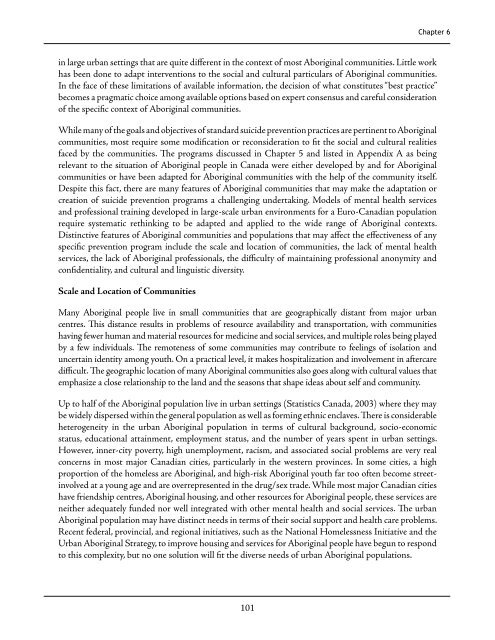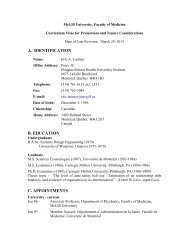Chapter 6<strong>in</strong> large urban sett<strong>in</strong>gs that are quite different <strong>in</strong> the context of most <strong>Aborig<strong>in</strong>al</strong> communities. Little workhas been done to adapt <strong>in</strong>terventions to the social and cultural particulars of <strong>Aborig<strong>in</strong>al</strong> communities.In the face of these limitations of available <strong>in</strong>formation, the decision of what constitutes “best practice”becomes a pragmatic choice among available options based on expert consensus and careful considerationof the specific context of <strong>Aborig<strong>in</strong>al</strong> communities.While many of the goals and objectives of standard suicide prevention practices are pert<strong>in</strong>ent to <strong>Aborig<strong>in</strong>al</strong>communities, most require some modification or reconsideration to fit the social and cultural realitiesfaced by the communities. The programs discussed <strong>in</strong> Chapter 5 and listed <strong>in</strong> Appendix A as be<strong>in</strong>grelevant to the situation of <strong>Aborig<strong>in</strong>al</strong> people <strong>in</strong> <strong>Canada</strong> were either developed by and for <strong>Aborig<strong>in</strong>al</strong>communities or have been adapted for <strong>Aborig<strong>in</strong>al</strong> communities with the help of the community itself.Despite this fact, there are many features of <strong>Aborig<strong>in</strong>al</strong> communities that may make the adaptation orcreation of suicide prevention programs a challeng<strong>in</strong>g undertak<strong>in</strong>g. Models of mental health servicesand professional tra<strong>in</strong><strong>in</strong>g developed <strong>in</strong> large-scale urban environments for a Euro-Canadian populationrequire systematic reth<strong>in</strong>k<strong>in</strong>g to be adapted and applied to the wide range of <strong>Aborig<strong>in</strong>al</strong> contexts.Dist<strong>in</strong>ctive features of <strong>Aborig<strong>in</strong>al</strong> communities and populations that may affect the effectiveness of anyspecific prevention program <strong>in</strong>clude the scale and location of communities, the lack of mental healthservices, the lack of <strong>Aborig<strong>in</strong>al</strong> professionals, the difficulty of ma<strong>in</strong>ta<strong>in</strong><strong>in</strong>g professional anonymity andconfidentiality, and cultural and l<strong>in</strong>guistic diversity.Scale and Location of CommunitiesMany <strong>Aborig<strong>in</strong>al</strong> people live <strong>in</strong> small communities that are geographically distant from major urbancentres. This distance results <strong>in</strong> problems of resource availability and transportation, with communitieshav<strong>in</strong>g fewer human and material resources for medic<strong>in</strong>e and social services, and multiple roles be<strong>in</strong>g playedby a few <strong>in</strong>dividuals. The remoteness of some communities may contribute to feel<strong>in</strong>gs of isolation anduncerta<strong>in</strong> identity among youth. On a practical level, it makes hospitalization and <strong>in</strong>volvement <strong>in</strong> aftercaredifficult. The geographic location of many <strong>Aborig<strong>in</strong>al</strong> communities also goes along with cultural values thatemphasize a close relationship to the land and the seasons that shape ideas about self and community.Up to half of the <strong>Aborig<strong>in</strong>al</strong> population live <strong>in</strong> urban sett<strong>in</strong>gs (Statistics <strong>Canada</strong>, 2003) where they maybe widely dispersed with<strong>in</strong> the general population as well as form<strong>in</strong>g ethnic enclaves. There is considerableheterogeneity <strong>in</strong> the urban <strong>Aborig<strong>in</strong>al</strong> population <strong>in</strong> terms of cultural background, socio-economicstatus, educational atta<strong>in</strong>ment, employment status, and the number of years spent <strong>in</strong> urban sett<strong>in</strong>gs.However, <strong>in</strong>ner-city poverty, high unemployment, racism, and associated social problems are very realconcerns <strong>in</strong> most major Canadian cities, particularly <strong>in</strong> the western prov<strong>in</strong>ces. In some cities, a highproportion of the homeless are <strong>Aborig<strong>in</strong>al</strong>, and high-risk <strong>Aborig<strong>in</strong>al</strong> youth far too often become street<strong>in</strong>volvedat a young age and are overrepresented <strong>in</strong> the drug/sex trade. While most major Canadian citieshave friendship centres, <strong>Aborig<strong>in</strong>al</strong> hous<strong>in</strong>g, and other resources for <strong>Aborig<strong>in</strong>al</strong> people, these services areneither adequately funded nor well <strong>in</strong>tegrated with other mental health and social services. The urban<strong>Aborig<strong>in</strong>al</strong> population may have dist<strong>in</strong>ct needs <strong>in</strong> terms of their social support and health care problems.Recent federal, prov<strong>in</strong>cial, and regional <strong>in</strong>itiatives, such as the National Homelessness Initiative and theUrban <strong>Aborig<strong>in</strong>al</strong> Strategy, to improve hous<strong>in</strong>g and services for <strong>Aborig<strong>in</strong>al</strong> people have begun to respondto this complexity, but no one solution will fit the diverse needs of urban <strong>Aborig<strong>in</strong>al</strong> populations.101
Chapter 6Access to ServicesEven with the counsell<strong>in</strong>g services through the hospital, you have to have a recommendationfrom a doctor and there’s a long wait<strong>in</strong>g period before there’s a free space so that you cansee the counsellor. And if you’ve got a problem that’s happen<strong>in</strong>g right now, wait<strong>in</strong>g threeweeks to see a counsellor isn’t the best solution (First Nation youth).For geographical, historical, and economic reasons there is a lack of resources available <strong>in</strong> many communitiesfor mental health programs. Indeed, most communities have limited availability of mental health services,which largely fall under “non-<strong>in</strong>sured health benefits” adm<strong>in</strong>istered by the First Nations and Inuit HealthBranch of Health <strong>Canada</strong> (Advisory Group on <strong>Suicide</strong> Prevention, 2003). Most mental health care isprovided by primary care cl<strong>in</strong>icians (nurses and family physicians) or community workers.Primary care cl<strong>in</strong>icians and helpers must be tra<strong>in</strong>ed to be able to detect and respond to potentially suicidal<strong>in</strong>dividuals. The will<strong>in</strong>gness to recognize problems depends, <strong>in</strong> part, on the cl<strong>in</strong>ician’s confidence <strong>in</strong>treatment. Treatment skills are particularly important for nurse practitioners and family physicians whowork <strong>in</strong> remote communities where there is little specialized mental health expertise available. Specificareas relevant to suicide where additional tra<strong>in</strong><strong>in</strong>g <strong>in</strong> treatment approaches may be needed <strong>in</strong>clude majordepression, anxiety disorders, substance abuse, family violence, and sexual abuse.Mental health workers <strong>in</strong> remote settlements may experience more isolation than their counterparts whowork <strong>in</strong> cities. Workers <strong>in</strong> remote communities must operate without the backup of other professionals andresources needed to deal with crises (e.g. supervised sett<strong>in</strong>gs, psychiatric consultation, day-hospital programs,family <strong>in</strong>tervention). Unfortunately, there often are arbitrary divisions and a lack of communication amongschool, social services, and health personnel even <strong>in</strong> small communities. This isolation and fragmentation ofservices must be counteracted to provide support for workers and cont<strong>in</strong>uity of care.Availability of <strong>Aborig<strong>in</strong>al</strong> Mental Health WorkersFew <strong>Aborig<strong>in</strong>al</strong> people have had the opportunity to pursue professional tra<strong>in</strong><strong>in</strong>g <strong>in</strong> mental health. This ischang<strong>in</strong>g and a new generation of helpers is emerg<strong>in</strong>g who are able to put together <strong>Aborig<strong>in</strong>al</strong> knowledgeof health and heal<strong>in</strong>g with the most useful and relevant aspects of psychiatry and psychology. However,conflicts and contradictions between biomedic<strong>in</strong>e and local ways of understand<strong>in</strong>g affliction and heal<strong>in</strong>gcan occur; therefore, models of <strong>in</strong>tegration or conflict resolution must be developed.Given the lack of tra<strong>in</strong>ed mental health workers <strong>in</strong> many <strong>Aborig<strong>in</strong>al</strong> communities and the crucialimportance of cultural and l<strong>in</strong>guistic knowledge <strong>in</strong> treatment, it is essential to extend tra<strong>in</strong><strong>in</strong>g programsto local community workers, healers, church leaders, and other “natural” helpers. Professional tra<strong>in</strong><strong>in</strong>gcan be adapted to the needs and perspectives of these groups so that they can both provide various typesof supportive <strong>in</strong>tervention and work with professionals when necessary.Privacy and ConfidentialityI’m not sure exactly how this would work but the idea that was touched on before thatit’s easier to talk to a stranger than someone that, well, not a stranger, but someone thatyou know, don’t know necessarily personally, I suppose, is easier to talk to. So if somehow102
- Page 1 and 2:
Suicide Among Aboriginal Peoplein C
- Page 3 and 4:
Aboriginal Healing Foundation75 Alb
- Page 6 and 7:
Table of ContentsPreface...........
- Page 8 and 9:
Table of ContentsCultural and Lingu
- Page 10:
PrefaceThis report was prepared und
- Page 14 and 15:
GlossaryAmbivalence - Ambivalence r
- Page 16 and 17:
GlossaryParasuicide - Any acute, in
- Page 18 and 19:
Chapter 1IntroductionWhen I was 14
- Page 20 and 21:
Chapter 1Definitions of Suicide and
- Page 22 and 23:
Chapter 1Methods of Studying Suicid
- Page 24 and 25:
Chapter 1suicide attempts (Marttune
- Page 26 and 27:
Chapter 1A central problem for cros
- Page 28 and 29:
Chapter 2The Epidemiology of Suicid
- Page 30 and 31:
Chapter 2the economic status of Abo
- Page 32 and 33:
Chapter 2No study to date has syste
- Page 34 and 35:
Chapter 2Despite the overall patter
- Page 36 and 37:
Chapter 2Figure 2-6) Average Annual
- Page 38 and 39:
Chapter 2are only a portion of thos
- Page 40 and 41:
Chapter 2Figure 2-9) Suicide Rates
- Page 42 and 43:
Chapter 2Indeed, the rising rate of
- Page 44 and 45:
Chapter 2Figure 2-11) Number of Dea
- Page 46 and 47:
Chapter 2Rate per 100,000 populatio
- Page 48 and 49:
Chapter 2There are only a handful o
- Page 50 and 51:
Chapter 3Origins of Suicide: Indivi
- Page 52 and 53:
Chapter 3Anxiety disorders also car
- Page 54 and 55:
Chapter 3Many of the factors associ
- Page 56 and 57:
Chapter 3American Indians compared
- Page 58 and 59:
Chapter 3genetic and constitutional
- Page 60 and 61:
Chapter 3Single-parent families are
- Page 62 and 63:
Chapter 3Hopelessness, Problem Solv
- Page 64 and 65:
Chapter 3higher rates of suicidal b
- Page 66 and 67:
Chapter 3Physical EnvironmentSuicid
- Page 68 and 69: Chapter 31990; Chandler, 1994). Thi
- Page 70 and 71: Chapter 3Risk FactorsDepressionSubs
- Page 72 and 73: Chapter 4Origins of Suicide: Social
- Page 74 and 75: Chapter 4Reserves, Settlements, and
- Page 76 and 77: Chapter 4Traditionalism versus accu
- Page 78 and 79: Chapter 4are equivalent in seriousn
- Page 80 and 81: Chapter 4society (Levy and Kunitz,
- Page 82 and 83: Chapter 4those of mother and homema
- Page 84 and 85: Chapter 4Duncan Campbell Scott, Dep
- Page 86 and 87: Chapter 4Traditional Aboriginal com
- Page 88 and 89: Chapter 4Feehan, 1996; Grant, 1996;
- Page 90 and 91: Chapter 4The Child Welfare System a
- Page 92 and 93: Chapter 4Aboriginal communities and
- Page 94 and 95: Chapter 4had extremely high rates.
- Page 96 and 97: Chapter 4Figure 4-2) Transgeneratio
- Page 98 and 99: Chapter 5What Works in Suicide Prev
- Page 100 and 101: Chapter 5Table 5-1) Strategies of I
- Page 102 and 103: Chapter 5Effective Suicide Preventi
- Page 104 and 105: Chapter 5closet rods that give way
- Page 106 and 107: Chapter 5The American Indian Life S
- Page 108 and 109: Chapter 51) school-based and commun
- Page 110 and 111: Chapter 5reduce suicides that follo
- Page 112 and 113: Chapter 5Although they may visit a
- Page 114 and 115: Chapter 6Conclusion: Understanding
- Page 116 and 117: Chapter 6Figure 6-1) An Integrative
- Page 120 and 121: Chapter 6there’s like a program s
- Page 122 and 123: Chapter 6Figure 6-2) Levels of Inte
- Page 124 and 125: Chapter 6Planning and CoordinationA
- Page 126 and 127: Chapter 62) The response to the cri
- Page 128: Chapter 6Often, suicide is a respon
- Page 131 and 132: Appendix AASIST participants receiv
- Page 133 and 134: Appendix AThe Training for Youth Ed
- Page 135 and 136: Appendix AThe program has continued
- Page 137 and 138: Appendix Awith the creation and imp
- Page 139 and 140: Appendix AContact Information for R
- Page 142 and 143: Appendix BAdditional Resources: Man
- Page 144: Appendix BAboriginal Healing and We
- Page 147 and 148: Appendix CNational Aboriginal Healt
- Page 149 and 150: References——— (1987). Unravel
- Page 151 and 152: ReferencesBeck, A.T., R.A. Steer, M
- Page 153 and 154: ReferencesBrent, D.A., J.A. Perper,
- Page 155 and 156: References——— (1995). The Pro
- Page 157 and 158: ReferencesDevereux, G. (1961). Moha
- Page 159 and 160: References——— (2005b). In wha
- Page 161 and 162: ReferencesGardiner, H. and B. Gaida
- Page 163 and 164: ReferencesGuo, B. and C. Harstall (
- Page 165 and 166: ReferencesHoberman, H.M. and B.D. G
- Page 167 and 168: ReferencesJong, M. (2004). Managing
- Page 169 and 170:
ReferencesKouri, R. (2003). Persona
- Page 171 and 172:
References——— (1997). Suicide
- Page 173 and 174:
ReferencesMatheson, L. (1996). The
- Page 175 and 176:
ReferencesNeimeyer, R.A., B. Fortne
- Page 177 and 178:
ReferencesPirkis, J.E., C.E. Irwin,
- Page 179 and 180:
ReferencesRutz, W. (2001). Preventi
- Page 181 and 182:
References——— (1992). Marriag
- Page 183 and 184:
ReferencesTrimble, J. and B. Medici
- Page 185 and 186:
ReferencesWebb, J.P. and W. Willard
















